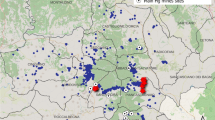Summary
Circadian rhythms in the urinary excretion of eleven heavy metals and organic substances were examined under free, water-restrictive and water-loading conditions for 6 d (2 d for each of the three conditions) in twenty metal workers exposed to lead, zinc and copper. Circadian rhythms were found for all heavy metals and organic substances as well as for urinary flow (UF) rate, creatinine (Cn) and total urinary solutes (TUS). The Cn rhythm was significantly unparallel to the OF rhythm under the water-loading condition, indicating that the two rhythms were essentially different from each other. Circadian rhythms of the eleven urinary substances were then related to the Cn and OF rhythms, using profile analysis. The results indicated that the rhythms in the manganese, chromium, copper and beta-2-microglobulin excretion depend on the Cn rhythm, i.e. the rhythm of glomerular filtration; the rhythms in the hippuric acid, delta-aminolevulinic acid and TUS excretion are on the OF rhythm, i.e. the rhythm of reabsorption by the distal tubule and collecting duct. On the other hand, the rhythms in the lead, inorganic mercury, cadmium, zinc and coproporphyrin excretion were considered as reflecting complex renal excretory mechanisms.
Similar content being viewed by others
References
Araki S, Murata K, Yokoyama K, Yanagihara S, Niinuma Y, Yamamoto R, Ishihara N (1983) Circadian rhythms in the urinary excretion of metals and organic substances in “healthy” men. Arch Environ Health 38:360–366
Araki S, Aono H, Murata K (1985) Circadian rhythms of heavy metals and organic substances in plasma, erythrocytes and urine in metal workers. In: Proceedings of 58th annual meeting of Japan Association of Industrial Health, vol 1. Japan Association of Industrial Health, Kitakyushu, pp 202–203, [in Japanese]
Araki S, Aono H, Murata K (1986) Adjustment of urinary concentration to urinary volume in relation to erythrocyte and plasma concentrations: an evaluation of urinary heavy metals and organic substances. Arch Environ Health 41:171–177
Araki S, Aono H, Yokoyama K, Murata K (1986) Filterable plasma concentration, glomerular filtration, tubular balance, and renal clearance of heavy metals and organic substances in metal workers. Arch Environ Health 41:216–221
Araki S, Aono H, Murata K (1986) Mobilisation of heavy metals into the urine by CaEDTA: relation to erythrocyte and plasma concentrations and exposure indicators. Br J Ind Med 43:636–641
Bhattacharya RD (1979) Circadian rhythmic aspects of urinary zinc excretion in presumably healthy subjects. Pan Minerva Med 21:201–203
Bucher JP, Roels H, Bernard A, Lauwerys R (1980) Assessment of renal function of workers exposed to inorganic lead, cadmium or mercury vapor. J Occup Med 22:741–750
Conroy RTWL, Mills JN (1970) The kidney. In: Human circadian rhythms. Churchill, London, pp 47–67
Evrin P-E, Wibell L (1972) The serum levels and urinary excretion of beta-2-microglobulin in apparently healthy subjects. Scand J Clin Lab Invest 29:69–74
Friberg L, Piscator M, Nordberg GF, Kjellstroem T (1974) Cadmium in the environment, 2nd edn. CRC Press, Ohio, pp 41–42
George CPL, Messerli FH, Genest J, Nowaczynski W, Boucher R, Rojo-Ortega M (1975) Diurnal variation of plasma vasopressin in man. J Clin Endocrinol Metab 41:332–338
Lifschitz MD, Henkin RI (1971) Circadian variation in copper and zinc in man. J Appl Physiol 31:88–92
Magos L (1971) Selective atomic-absorption determination of inorganic mercury and methylmercury in undigested biological samples. Analyst 96:847–853
Magos L, Clarkson TW (1972) Atomic absorption determination of total, inorganic, and organic mercury in blood. JAOAC 55:966–971
Molyneux MKB (1964) Use of single urine samples for the assessment of lead absorption. Br J Ind Med 21:203–209
Morrison DF (1976) Multivariate statistical method, 2nd edn. McGraw-Hill, New York, pp 153–160
Ogata M, Tomokuni K, Takatsuka Y (1969) Quantitative determination in urine of hippuric acid and m- or p-methyl hippuric acid, metabolites of toluene and m- or p-xylene. Br J Ind Med 26:330–334
Piotrowski JK, Trojanowska B, Mogilnicka EM (1975) Excretion kinetics and variability of urinary mercury in workers exposed to mercury vapour. Int Arch Occup Environ Health 35:245–256
Soulsby J, Smith RL (1974) A simplified method for the quantitative determination of urinary coproporphyrin in lead workers. Br J Ind Med 31:72–74
Subramanian KS, Méranger JE (1984) Diurnal variations in the concentration of cadmium in urine. Clin Chem 30: 1110–1111
Subramanian KS, Méranger J-C, MacKeen JE (1983) Graphite furnace atomic absorption spectrometry with matrix modification for determination of cadmium and lead in human urine. Anal Chem 55:1064–1067
Szadkowski D, Borkamp A, Lehnert G (1980) Hippursdureausscheidung im Harn in Abhängigkeit von Tagesrhythmik und alimentdren Einflüssen. Int Arch Occup Environ Health 45:141–152
Tomokuni K, Ogata M (1972) Simple method for determination of urinary delta-aminolevulinie acid as an index of lead exposure. Clin Chem 18:1534–1536
Vokac Z, Gundersen N, Magnus P, Jebens E, Bakka T (1980) Circadian rhythmicity of the urinary excretion of mercury, potassium and catecholamines in unconventional shift-work systems. Scand J Work Environ Health 6:188–196
Watanabe H, Araki S, Sakata M, Yanagihara S, Ushio K (1972) 24-Hour urinary hippuric acid excretion in “healthy” people, thinner workers and thinner addicts. J Jpn Accident Med Assoc 20:577–579 [in Japanese]
Wesson LG (1965) Physiology of the kidney. In: Alken CE, Dix VW, Weyrauch HM, Wildbolz E (eds) Encyclopedia of urology, vol 2: physiology and pathological physiology. Springer, Berlin Heidelberg, pp 1–386
Author information
Authors and Affiliations
Rights and permissions
About this article
Cite this article
Aono, H., Araki, S. Circadian rhythms in the urinary excretion of heavy metals and organic substances in metal workers in relation to renal excretory mechanism: profile analysis. Int. Arch Occup Environ Heath 60, 1–6 (1988). https://doi.org/10.1007/BF00409371
Received:
Accepted:
Issue Date:
DOI: https://doi.org/10.1007/BF00409371




